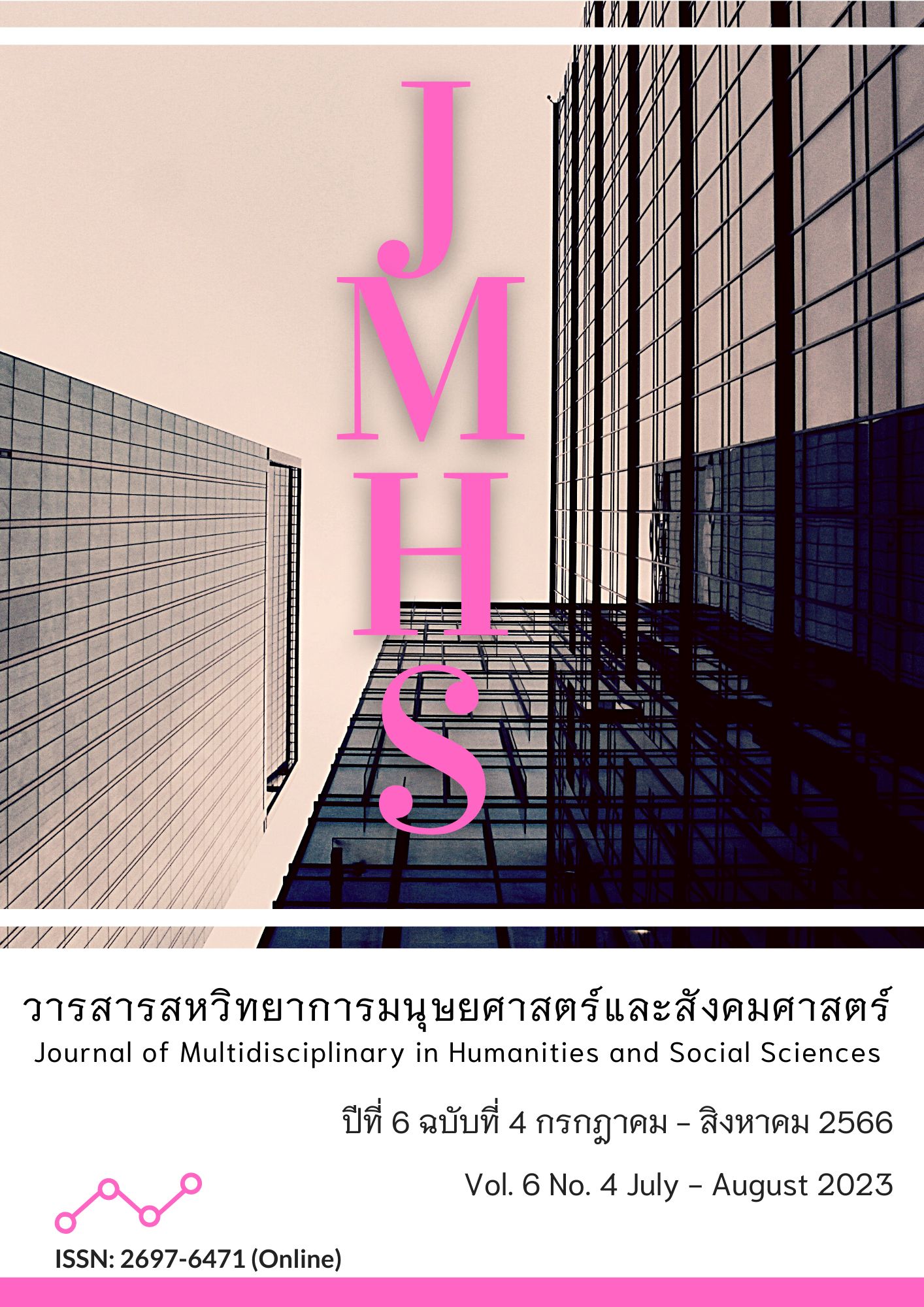Causal Factors Influencing Repurchase Intention for Kitchenware on Shopee Application of Consumers in Bangkok and Its Vicinity
Main Article Content
Abstract
The article aimed to 1) develop and validate a causal relationship model of kitchenware repurchase intention via the Shopee application in Bangkok and its vicinity; and 2) study causal factors influencing kitchenware repurchase intention via the Shopee application in Bangkok and its vicinity. This study was quantitative research. The sample consisted of 400 people who had bought kitchenware via the Shopee application and lived in Bangkok and its vicinity. The tools used in the research were online questionnaires. The statistics used in data analysis were frequency, percentage, confirmatory factor analysis, and the structural equation model.
The results of this research were the development of causal relationship models consisting of 4 components: 1) perceived application quality; 2) satisfaction; 3) trust; and 4) repurchase intention; and the model were consistent with the empirical data to a great extent. The statistics showed CMIN/df = 1.89, CMIN = 308.29, df = 163, GFI = 0.93, AGFI = 0.91, SRMR = 0.03, and RMSEA = 0.05. The final predictive coefficient was 0.82, indicating that the variables in the model can explain the variance of the repurchase intention via the Shopee application by 82 percent. It was found that trust was the most direct influence on repurchase intention for kitchenware products via the Shopee application. The results of this research are useful for entrepreneurs who sell kitchenware products. They should consider having trust occur throughout the purchase in order to plan and create a strategy to achieve repeat purchase intentions next time.
Article Details

This work is licensed under a Creative Commons Attribution-NonCommercial-NoDerivatives 4.0 International License.
Views and opinions appearing in the Journal it is the responsibility of the author of the article, and does not constitute the view and responsibility of the editorial team.
References
กิตติพัฒน์ พันเรือง และ ดัชกรณ์ ตันเจริญ. (2563). การวิเคราะห์ปัจจัยที่มีผลต่อการซื้อซํ้าของตลาดกลางพาณิชย์อิเล็กทรอนิกส์ในกรุงเทพและปริมณฑล. วารสารวิทยาการและเทคโนโลยีสารสนเทศ, 10(2), 49-58. สืบค้นจาก https://ph02.tci-thaijo.org/index.php/JIST/article/view/241777
กฤษฎา ฟักสังข์ และ สมชาย เล็กเจริญ. (2564). ปัจจัยเชิงสาเหตุที่มีอิทธิพลต่อความตั้งใจซื้อซ้ำแพ็กเกจทัวร์ผ่านแอปพลิเคชันอโกด้าของผู้บริโภคในเขตกรุงเทพมหานครและปริมณฑล. วารสารวิชาการมหาวิทยาลัยหอการค้าไทย มนุษยศาสตร์และสังคมศาสตร์, 41(3), 42-32. สืบค้นจาก https://so06.tci-thaijo.org/index.php/utccjournalhs/article/view/246946
ฉันธะ จันทะเสนา. (2562). ตัวแปรที่มาก่อนของการตั้งใจซื้อซ้ําในพาณิชย์อิเล็กทรอนิกส์ไทย. วารสารการพัฒนาทรัพยากรมนุษย์และองค์การ, 11(2), 49-57. สืบค้นจาก https://so01.tci-thaijo.org/index.php/HRODJ/article/download/163593/156946/
บิวณิชา พุทธเกิด. (2565). อิทธิพลของคุณภาพบริการอิเล็กทรอนิกส์และความไว้วางใจต่อความตั้งใจซื้อซ้ำของการซื้อสินค้าออนไลน์ในประเทศไทย. วารสารเศรษฐศาสตร์และบริหารธุรกิจ มหาวิทยาลัยทักษิณ, 14(3), 153-155. สืบค้นจาก https://so01.tci-thaijo.org/index.php/ecbatsu/article/view/249536
วรันพร นางาม. (2561). อิทธิพลของปัจจัยเชิงสาเหตุที่ส่งผลต่อความตั้งใจซื้อซ้ำอาหารคลีนของผู้บริโภคในเขตกรุงเทพมหานคร. วารสารวิชาการ สถาบันเทคโนโลยีแห่งสุวรรณภูมิ, 5(1), 81-95. สืบค้นจาก https://so04.tci-thaijo.org/index.php/svittj/article/view/194545
วินิจ แซ่เตียว และ สุรสิทธิ์ อุดมธนวงศ์. (2563). ปัจจัยเชิงสาเหตุที่ส่งผลต่อความตั้งใจในการซื้อซ้ำของผู้บริโภคที่ใช้ผลิตภัณฑ์ลดอาการเมาค้าง ในเขตกรุงเทพมหานคร. วารสารสถาบันเทคโนโลยีไทย-ญี่ปุ่น : บริหารธุรกิจและภาษา, 8(1), 55-57. สืบค้นจาก https://so06.tci-thaijo.org/index.php/TNIJournalBA/article/view/240062
สำนักข่าวสปริงนิวส์. (2565, พฤษภาคม 27). คนอยู่บ้านช่วงโควิด-19 ทำอาหารมากขึ้น ดันตลาดเครื่องครัวโตเต็มสูบ. สืบค้นเมื่อ 28 กุมภาพันธ์ 2566, จาก https://www.springnews.co.th/news/809976
สำนักงานพัฒนาธุรกรรมทางอิเล็กทรอนิกส์. (2565). รายงานผลการสำรวจพฤติกรรมผู้ใช้อินเทอร์เน็ตอินเทอร์เน็ตในประเทศไทย ปี 2565. สืบค้นเมื่อ 28 กุมภาพันธ์ 2566, จากhttps://www.etda.or.th/getattachment/78750426-4a58-4c36-85d3-d1c11c3db1f3/IUB-65-Final.pdf.aspx
สุจิตรา ด้วงทอง. (2564). ปัจจัยที่มีผลต่อความพึงพอใจของผู้ใช้บริการเว็บไซต์. วารสารการพัฒนางานประจำสู่งานวิจัย, 8(1), 25-35. สืบค้นจาก https://so03.tci-thaijo.org/index.php/jpr2r/article/view/250639/170823
ศิวะพร ขจรศักดิ์สิริกุ และ บรรดิษฐ พระประทานพร. (2563). กลยุทธ์การตลาดโซเชียลมีเดียที่ส่งผลต่อการตัดสินใจซื้อสินค้าในเว็บไซต์ช้อปปี้ ในยุควิกฤติโควิด-19. วารสารวิทยาลัยโลจิสติกส์และซัพพลายเชน, 6(2), 91. สืบค้นจาก https://so03.tcithaijo.org/index.php/Logis_j/article/view/242148/167381
อันธิกา หยองอนุกูล และ สุมามาลย์ ปานคำ. (2565). ปัจจัยเชิงสาเหตุที่มีผลต่อความตั้งใจซื้อซ้ำสินค้าบนเว็บไซต์ซูเปอร์มาร์เก็ตของผู้บริโภคในเขตกรุงเทพมหานครและปริมณฑล. วารสารบัณฑิตศาส์น มหาวิทยาลัยมหามกุฏราชวิทยาลัย, 20(1), 49-60. สืบค้นจาก https://so04.tci-thaijo.org/index.php/mgsj/article/view/259596
Fan, Y. L., & Kim, I. (2013). The Impact of Website Quality on Flow-Related Online Shopping Behavior in C2 C E-Marketplaces A Cross-National Study. Perceived Application Quality: An International Journal, 23(5), 364-387. https://doi.org/10.1108
Ghalandari, K., & Narouzi, A. (2012). The Effect of Country of Origin on Purchase Intention: The Role of Product Knowledge. Research Journal of Applied Sciences Engineering And Technology, 4(9), 1166-1171.
Hair, J. F., Black, W. C., Babin, B. J., & Anderson, R. E. (2010). Multivariate Data Analysis. (7th ed.). Upper Saddle River, NJ: Prentice-Hall.
Hair, J. F., Hult, G. T. M., Ringle, C. M., & Sarstedt, M. (2014). A Primer on Partial Least Squares Structural Equation Modeling (PLS-SEM). California, CA: Sage publications.
Hu, L.T., & Bentler, P. M. (1999). Cutoff Criteria for Fit Indexes in Covariance Structure Analysis: Conventional Criteria Versus New Alternatives. Structural Equation Modeling, 6(1), 1-55. https://doi.org/10.1080/10705519909540118
Hoelter, J. W. (1983). The Effects of Role Evaluation and Commitment on Identity Salience. Social Psychology Quarterly, 46(2), 140-147. https://doi.org/10.2307/3033850
Joreskog, K. G., & Sorbom, D. (1984). Advances in Factor Analysis and Structural Equation Models. Lanham: Rowman & Littlefield Publishers.
Kline, R. B. (2011). Principles and Practices of Structural Equation Modeling. (3rd ed.). New York: The Guilford Press.
Lu, L., Allan L., Dogan G., & Nathan N. (2016). Work Engagement, Job Satisfaction, and Turnover Intentions: A Comparison between Supervisors and Line-Level Employees. International Journal of Contemporary Hospitality Management, 28(4), 737-761.
Wijaya, R., Farida, N., & Andriyansah. (2018). Determinants of Repurchase Intentions at Online Stores in Indonesia. International Journal of E-Business Research, 4(3), 95-111.
Schreiber, J. B., Stage, F. K., King, J., Nora, A., & Barlow, E. A. (2006). Reporting Structural Equation Modeling and Confirmatory Factor Analysis Results a Review. The Journal of Educational Research, 99(6), 323-337. https://doi.org/10.3200/JOER.99.6.323-338
Schumacker, R. E., & Lomax, R. G. (2004). A Beginner's Guide to Structural Equation Modeling. (2nd ed.). New Jersey: Lawrence Erlbaum Associates Publishers.
Thompson, B. (2004). Exploratory and Confirmatory Factor Analysis: Understanding Concepts and Applications. American Psychological Association.
Ullman, M. T. (2001). The Declarative/procedural Model of Lexicon and Grammar. Journal of Psycholinguistic Research, 30(1), 37-69. https://doi.org/10.1023/A:1005204207369
Wang, W-T., Wang, Y-S., & Liu, E-R. (2016). The Stickiness Intention of Group-Buying Websites. Information and Management, 53(5), 625-642. https://doi.org/10.1016/j.im.2016.01.006
Wen, C., Prybutok, V.R., & Xu, C. (2014). An Integrated Model for Customer Online Repurchase Intention. Journal of Computer Information Systems, 52(1), 14-23.


